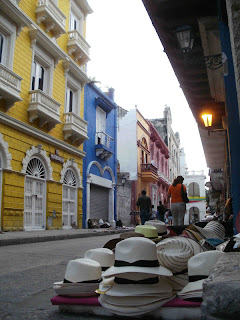Afro-Latin music and rhythmic sounds, . . . click, clack . . click, clack . . click, clack . . horseshoes hitting the cobble and brick stone streets, vendors calling out “fresh fruit for sale”, engulf the atmosphere in “Cartagena de Indias”. The weather is always warm. Today, it’s 90 degrees (Fahrenheit) with 90% humidity. Occasional cool breezes sweep in during the day, and more frequently at night. A five minute walk outside during the day results in my shirt drenched with sweat.
Colorful fruit vendors, there is a large population of Afro Colombians in Cartagena
The sound of horseshoes hitting the payment is constant
Narrow streets, colonial architecture, and Panama hats epitomize the colonial city
The local people all move at a slower pace than in the USA or Europe. I adopted this way of walking - a controlled, deliberate stroll. No one moves fast in the tropics. I started carrying a bandana to wipe perspiration off my face, neck, and chest. I constantly drank freshly squeezed orange, mango, pineapple, melon, or maracuja juices. The ripe tropical fruits are abundant. The seafood is delectable.
Ripe, fresh maracuja fruit makes a tasty citrus juice
Local people are delightful, friendly, and want to have fun
Historic Cartagena is built on an island and surrounded by a Spanish colonial brick and mortar wall to protect the city from pirates and other invaders. The buildings are sixteenth century colonial architecture, with balconies surrounded by stylized wrought iron, outdoor garden courtyards in the middle, with blooming red, orange, purple bougainvillea, and tree shaded or open parks. There are numerous cafes and restaurants with open air sitting reminding one of outdoor European diners. Across a bridge from the historic center is modern Cartagena with high rise buildings, modern beach facilities, and shops with the latest fashion and vogue trends.
Historic walled city on the right, modern Cartagena on the left
Streets were built for horse and carriages, not cars
Colors of buildings of Cartagena
One of the many shaded public squares
Atop the wall surrounding the city with the Caribbean Sea in the background
Plaza Santo Domingo
Walking around the walled old city at night, I felt like I was in colonial Spanish America. When hunger overcame me, I stopped at Plaza Santo Domingo and had a seafood pasta dish in an outdoor cafe. Horse drawn carriages transported visitors through the narrow streets. Vendors peddled Panama hats, cigarettes, handcrafted jewelry, maracas, and exquisite water color paintings of old buildings and scenes from a bygone era.
Entrance to the walled city
Under these arches passed Liberator Simon Bolivar,
Nobel laureate Garcia Marquez, and President Obama
Plaza Santo Domingo at night
Seafood pasta: overpriced, but atmosphere was priceless
In front of the Plaza, there were Afro Colombian dancers performing pulsating fast hip moments with thrusting groins - very sensuous and suggestive of the “forbidden dance”. In the sixteenth century black African slaves were brought and sold in Cartagena, most entered South America through the city’s ports. These African dances are the same ones performed for hundreds of years and imported from ancient Africa. Today the young dancers looked like they were truly free. In the past, this was probably the only way African slaves were allowed to freely express themselves, through gyrating body movements and demonstration of jubilee. Children of families meandering around the plaza joined in the dancing and shouting. One could hardly hear conversations over the sounds of maracas, African drums, and whistles - very exciting.
Dancers dancing in a plaza that was once a slave market
Afro Colombian dancers in Plaza Santo Domingo performing ancient African dances
Strolling singers and guitar players serenaded people eating at the cafes with romantic songs of love. A constant stream of people paraded through the plaza. All were solicited to eat at the different restaurants. Private security guards shooed away the few beggars, but not vendors. There were many women wearing high heels walking hand in hand with lovers or would be lovers. The slightly overpriced meal I ordered was well worth the price for sitting and enjoying the atmosphere. It was an inexpensive form of entertainment. I stayed for two and a half hours after dinner at the outdoor cafe absorbing the fiesta. I sense that these scenes - Afro dancers, vendors, strolling musicians, families promenading, beautifully served seafood - have been occurring since Spanish colonization. Be prepared to fall in love with this colonial city.
Singers serenading couples to put them in the mood for "amor"
A newly married couple enjoying the jewel of the Indies
One of many open air plazas filled with cafes and people
I ended the evening on top of the fortified stone wall looking out to the Caribbean sea. Are those pirate ships in the distance coming to attack? No, just a mixture of waves, twilight, and imagination. An illusion easily made in Cartagena of the Indias.
City wall with cannon battlements from where I imaged pirate ships




















No comments:
Post a Comment